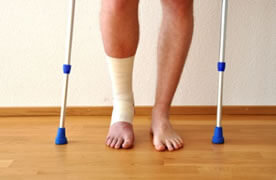





 When the time comes and your child starts walking on his or her own, it’s important to choose the right type of footwear for them. Footwear at a young age can impact how children’s feet develop as they grow older. Remember to look for shoes that are comfortable, breathable, soft, and lightweight. Avoid stiff leather and check that the sole is made of flexible and padded material. Shoes should have enough room for the toes to wiggle. Change them every few months as necessary.
When the time comes and your child starts walking on his or her own, it’s important to choose the right type of footwear for them. Footwear at a young age can impact how children’s feet develop as they grow older. Remember to look for shoes that are comfortable, breathable, soft, and lightweight. Avoid stiff leather and check that the sole is made of flexible and padded material. Shoes should have enough room for the toes to wiggle. Change them every few months as necessary.
Looking out for potential foot and ankle injuries as well as general health is vital in maintaining proper development in children’s feet.If you are having discomfort in your feet and would like to try orthotics, contact one of our podiatrists of Active Foot and Ankle Care, LLC. Our doctors will treat your foot and ankle needs.
Keeping Children's Feet Healthy
Having healthy feet in childhood can help prevent medical problems later in life, namely in the back and legs. As children grow, their feet require different types of care from birth to school-age.
Although babies do not walk yet, it is still very important to take care of their feet.
As a toddler, kids are now on the move and begin to develop differently. At this age toddlers are getting a feel for walking, so don’t be alarmed if your toddler is unsteady or ‘walks funny’. Be sure the child wears comfortable and protective shoes so that they can grow into their feet properly.
As your child gets older, it is important to teach them how to take care of their feet
Children of all ages are constantly developing and growing, and as a parent you want to make sure that nothing is hindering their maturation.
If you have any questions please feel free to contact our offices located in New Jersey. We offer the newest diagnostic tools and technologies to treat your foot and ankle needs.
 Minnesota’s Joey King, the only senior on the team, is out with a broken foot injury, at the time undetermined for how long. He is expected to miss the last two games of his school career. “It’s a crushing blow,” said Minnesota coach Richard Pitino, going on to say that “it makes a difficult situation much more difficult. But we just have to move on and do the best we can.”
Minnesota’s Joey King, the only senior on the team, is out with a broken foot injury, at the time undetermined for how long. He is expected to miss the last two games of his school career. “It’s a crushing blow,” said Minnesota coach Richard Pitino, going on to say that “it makes a difficult situation much more difficult. But we just have to move on and do the best we can.”
A broken foot requires immediate medical attention and treatment. To learn more, contact one of our podiatrists of Active Foot and Ankle Care, LLC. Our doctors will treat your foot and ankle needs.
Broken Foot Causes, Symptoms, and Treatment
A broken foot is caused by one of the bones in the foot typically breaking when bended, crushed, or stretched beyond its natural capabilities. Usually the location of the fracture indicates how the break occurred, whether it was through an object, fall, or any other type of injury.
Common Symptoms of Broken Feet:
Those that suspect they have a broken foot shoot seek urgent medical attention where a medical professional could diagnose the severity.
Treatment for broken bones varies depending on the cause, severity and location. Some will require the use of splints, casts or crutches while others could even involve surgery to repair the broken bones. Personal care includes the use of ice and keeping the foot stabilized and elevated.
If you have any questions please feel free to contact our offices located in New Jersey. We offer the newest diagnostic tools and technologies to treat your foot and ankle needs.
 According to triathlete-europe.competitor.com, eating your way to stress fracture recovery may be the way to go. The site suggests establishing “good pre- and post-training nutrition habits,” eating foods rich with nutrients such as iron, zinc, vitamin C, and antioxidants. Make sure to get adequate sleep, as “it assists with nutrient absorption and recovery.” Maintaining a healthy diet of protein and carbs will help with training and physical therapy as well as stress fracture prevention.
According to triathlete-europe.competitor.com, eating your way to stress fracture recovery may be the way to go. The site suggests establishing “good pre- and post-training nutrition habits,” eating foods rich with nutrients such as iron, zinc, vitamin C, and antioxidants. Make sure to get adequate sleep, as “it assists with nutrient absorption and recovery.” Maintaining a healthy diet of protein and carbs will help with training and physical therapy as well as stress fracture prevention.
Activities, where too much pressure is put on the feet can cause stress fractures. If you have any concerns contact one of our podiatrists of Active Foot and Ankle Care, LLC. Our doctors will treat your foot and ankle needs.
Dealing with Stress Fractures of the Foot and Ankle
The Stress Fractures occur on the foot and ankle when muscles in these areas weaken from too much or too little use. Then the feet and ankles lose support when walking or running from the impact of the ground. Since there is no protection the bones receive the full impact of each step. The stress on the feet causes cracks to form in the bones, thus called stress fractures.
What are Stress Fractures?
Stress fractures occur frequently in individuals whose daily activities cause great impact on the feet and ankles. Stress factors are most common among:
-runners
-people affected with Osteoporosis
-play tennis or basketball
-gymnastics
-high impact workouts
Symptoms
Pain from the fractures occur in the area of the fractures, and can be constant or intermittent. It will often cause sharp or dull pain with swelling and tenderness. Engaging in any kind of activity which involves in high impact will aggravate pain.
If you have any questions please feel free to contact our offices located in New Jersey. We offer the newest diagnostic tools and technologies to treat your foot and ankle needs.
 Michigan State Spartans coach Tom Izzo saaid “his top priority is making sure the plantar fasciitis doesn’t linger into next season.” Izzo was discussing the status of sophomore guard Lourawls Nairn Jr., who was on recovery from his plantar fasciitis condition. Izzo was unsure about Nairn Jr.’s status and whether he will be able to return to play for the next season. Nairn Jr. has been battling his plantar fasciitis since the summer and has been visiting doctors.
Michigan State Spartans coach Tom Izzo saaid “his top priority is making sure the plantar fasciitis doesn’t linger into next season.” Izzo was discussing the status of sophomore guard Lourawls Nairn Jr., who was on recovery from his plantar fasciitis condition. Izzo was unsure about Nairn Jr.’s status and whether he will be able to return to play for the next season. Nairn Jr. has been battling his plantar fasciitis since the summer and has been visiting doctors.
Plantar fasciitis can be very painful and inconvenient. If you are experiencing heel pain or symptoms of plantar fasciitis, contact one of our podiatrists of Active Foot and Ankle Care, LLC. Our doctors will treat your foot and ankle needs.
What is Plantar Fasciitis?
Plantar fasciitis is the inflammation of the thick band of tissue that runs along the bottom of your foot, known as the plantar fascia, and causes mild to severe heel pain.
What Causes Plantar Fasciitis?
· Excessive running
· Non-supportive shoes
· Overpronation
· Repeated stretching and tearing of the plantar fascia
How Can It Be Treated?
· Conservative measures – anti-inflammatories, ice packs, stretching exercises, physical therapy, orthotic devices
· Shockwave therapy – sound waves are sent to the affected area to facilitate healing and are usually used for chronic cases of plantar fasciitis
· Surgery – usually only used as a last resort when all else fails. The plantar fascia can be surgically detached from the heel
While very treatable, plantar fasciitis is definitely not something that should be ignored. Especially in severe cases, speaking to your doctor right away is highly recommended to avoid complications and severe heel pain. Your podiatrist can work with you to provide the appropriate treatment options tailored to your condition.
If you have any questions please feel free to contact our offices located in New Jersey. We offer the newest diagnostic tools and technologies to treat your foot and ankle needs.






